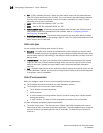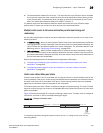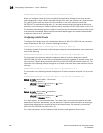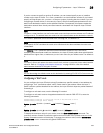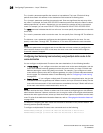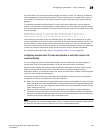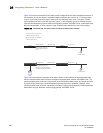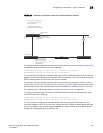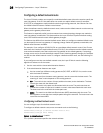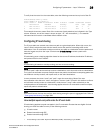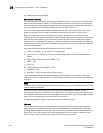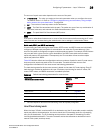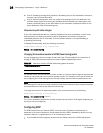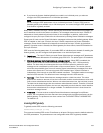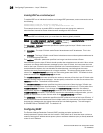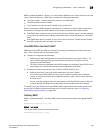
828 PowerConnect B-Series FCX Configuration Guide
53-1002266-01
Configuring IP parameters – Layer 3 Switches
26
Configuring a default network route
The Layer 3 Switch enables you to specify a candidate default route without the need to specify the
next hop gateway. If the IP route table does not contain an explicit default route (for example,
0.0.0.0/0) or propagate an explicit default route through routing protocols, the software can use
the default network route as a default route instead.
When the software uses the default network route, it also uses the default network route's next hop
gateway as the gateway of last resort.
This feature is especially useful in environments where network topology changes can make the
next hop gateway unreachable. This feature allows the Layer 3 Switch to perform default routing
even if the default network route's default gateway changes.
The feature thus differs from standard default routes. When you configure a standard default route,
you also specify the next hop gateway. If a topology change makes the gateway unreachable, the
default route becomes unusable.
For example, if you configure 10.10.10.0/24 as a candidate default network route, if the IP route
table does not contain an explicit default route (0.0.0.0/0), the software uses the default network
route and automatically uses that route's next hop gateway as the default gateway. If a topology
change occurs and as a result the default network route's next hop gateway changes, the software
can still use the default network route. To configure a default network route, use the following CLI
method.
If you configure more than one default network route, the Layer 3 Switch uses the following
algorithm to select one of the routes.
1. Use the route with the lowest administrative distance.
2. If the administrative distances are equal:
• Are the routes from different routing protocols (RIP, OSPF, or BGP4)? If so, use the route
with the lowest IP address.
• If the routes are from the same routing protocol, use the route with the best metric. The
meaning of “best” metric depends on the routing protocol:
• RIP – The metric is the number of hops (additional routers) to the destination. The best
route is the route with the fewest hops.
• OSPF – The metric is the path cost associated with the route. The path cost does not
indicate the number of hops but is instead a numeric value associated with each route.
The best route is the route with the lowest path cost.
• BGP4 – The metric is the Multi-exit Discriminator (MED) associated with the route. The
MED applies to routes that have multiple paths through the same AS. The best route is the
route with the lowest MED.
Configuring a default network route
You can configure up to four default network routes.
To configure a default network route, enter commands such as the following.
PowerConnect(config)# ip default-network 209.157.22.0
PowerConnect(config)# write memory
Syntax: ip default-network <ip-addr>
The <ip-addr> parameter specifies the network address.



